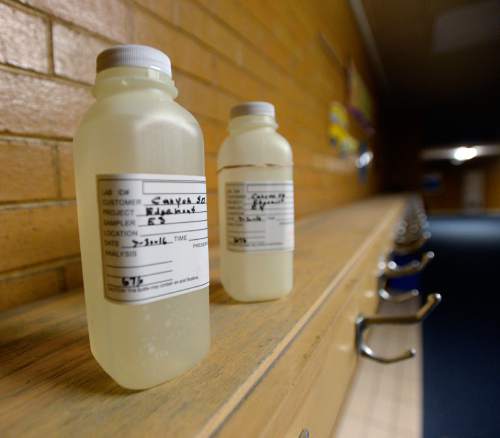This is an archived article that was published on sltrib.com in 2016, and information in the article may be outdated. It is provided only for personal research purposes and may not be reprinted.
Recent events in Flint, Mich., have turned the nation's attention to the harmful effects of lead pollution — and particularly to drinking water contaminated by the metal.
While environmental contamination is a concern, experts say the most common sources of lead may be found within your own home.
In the kitchen, with the lead pipe
Lead-based paint, found primarily in homes built prior to the 1960s, is the most common household source of lead and the most troublesome, according to the Environmental Protection Agency. But the EPA also encourages homeowners to have their tap water tested for lead, especially those whose homes were built prior to 1986, because old, corroded water pipes can become a localized source of lead contamination.
Water lines don't have to be made exclusively from lead for the metal to get in your drinking water. According to the EPA, brass and chrome-plated brass faucets and other plumbing fixtures, as well as the lead-based solder used to join pipes together, are the most common sources of lead contamination in drinking water.
Plumbing installed after 1986 is less likely to allow lead to leach into drinking water; that year, an amendment to the Safe Drinking Water Act limited the lead content of solder used in drinking water systems to .2 percent.
The EPA's standing position is that there is no safe level of lead exposure, as the metal tends to remain in the human body. When the metal reaches higher concentrations, it interferes with the neurological, cardiovascular and reproductive systems.
Children are considered to be especially at risk because lead interferes with growth — physical as well as intellectual.
Water contamination isn't the only problem associated with old water pipes. Over time, pipe corrosion results in pinhole leaks that cause water pressure issues and, eventually, structural damage, said Jim Sahs, a local home inspector with 22 years of experience.
How old are those pipes?
The best indicator is the home's age, Sahs said. Lead and cast iron fell out of favor as pipe materials at the beginning of the 20th century, but their replacement, galvanized steel, is notorious for corrosion and can be a source of lead contamination.
"Galvanized steel is the thing that, visually, you'll turn on the tub and see rust coming out of the water," Sahs said.
Copper became the material of choice for indoor plumbing after the 1950s, but Sahs said he still sees galvanized steel pipes in the majority of pre-1950 homes he inspects.
"They're getting old at this point," he said. "Usually I'm saying, 'this house is begging to be repiped.' "
To determine whether your older home has been repiped, Sahs said, look for clues under sinks or toilets or in unfinished basements or attics. Most homes will have either new plastic pipes, shiny copper pipes or silvery galvanized steel.
What's in the water?
It's also important to take the chemical nature of the water flowing through those pipes into account. Kenneth Bousfield, director of the Utah Division of Drinking Water, said most water in Utah contains a lot of dissolved minerals. Such water is "full" and unlikely to "eat" additional minerals or metals from piping, Bousfield said. So if you're frequently cleaning whiteish hard-water deposits off your sinks and shower heads, he said, the risk that your home's pipes are leaching lead is low.
But there are places in Utah where the water is naturally "hungry," Bousfield said.
"There is a single water system [in Weber County] that we've required to install corrosion control treatment," he said. "The water was nearly pure snowmelt and was just starving hungry, and as a result it would cause leaks in the plumbing."
It can be difficult to tell for sure whether metals are present in your drinking water, though a strange taste or color in the water can be an indicator, Bousfield said. If you're worried, he said, a good rule of thumb is to let the tap run until the water goes cold — about 30 seconds — before taking a drink or using that water to cook. This flushes out the water that has been sitting in your pipes and delivers clean water from the service line, where the water is regularly tested and monitored by the local provider.
epenrod@sltrib.com, Twitter: @EmaPen



